by Mark Tancig | Jun 4, 2018
In north Florida, the arrival of warm weather and plenty of rain means it’s time to battle the mosquitoes again. Those pesky little blood-suckers are out and about, often keeping us from enjoying our outdoor pursuits. With some preventative steps, you can reduce the potential for mosquitoes to occur in your yard.
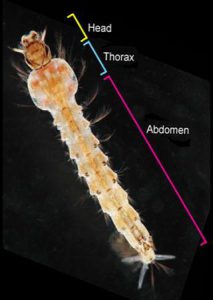
Mosquito larvae. Credit: Florida Medical Entomology Laboratory.
As we should all be aware of by now, mosquitoes require water to complete their lifecycle. Eggs are laid near the water and will dry out if they do not remain near a water source. The larvae, or “wrigglers”, that hatch from the eggs, are aquatic and will not survive out of water. The pupae, often called “tumblers”, are also aquatic and must be in water to survive. From the pupae hatch the adults, the growth stage we want to avoid.
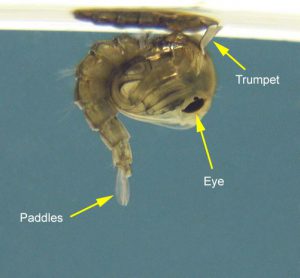
Mosquito pupae. Credit: Florida Medical Entomology Laboratory.
The best method to reduce mosquitoes in your yard is to remove or empty water-holding containers. This prevents the conditions needed for the egg through pupae stages to survive. These water-holding containers can include birdbaths, old buckets, gutters, tarps, rain barrels, and a variety of other items. Even a small bottlecap is enough to breed mosquitoes. Regularly emptying these water-holding containers every 3 to 5 days will stop that most annoying final life stage – the biting adults.
Another way to prevent the aquatic stages of mosquitoes from thriving is to use a larvaecide, specifically Bti. Bti is a bacterium that is sold as either small dunks or doughnuts and can also be found as small granules. Placing a dunk or a few granules in a birdbath will prevent larvae from developing and won’t harm the birds or other organisms that may visit, including frogs, bees, butterflies, and mammals. Bti is a selective pesticide, only effective for control of mosquito, midge, and fungus gnat larvae.
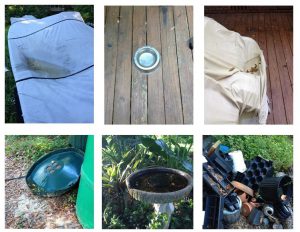
Various mosquito breeding habitats. Credit: Mark Tancig, UF/IFAS
Even if you’ve cleaned up or drained all water-holding containers on your property, there will likely still be some adult mosquitoes looking for a bloodmeal. Wearing long pants and sleeves, using mosquito repellents, and keeping window screens in good order are effective methods to prevent being bitten.
Local mosquito control agencies will often provide services to fog for adults. However, this will want to be your last resort, as the pesticides used to control adults are not as selective as the Bti used for the larvae. This results in non-target damage, meaning that insects besides mosquitoes, including beneficial insects, may also be harmed. Therefore, controlling mosquitoes during their aquatic lifestages helps reduce the need for pesticides that can harm beneficial insect populations.
The UF/IFAS Florida Medical Entomology Laboratory Research and Education Center has a great website – https://fmel.ifas.ufl.edu/ – of mosquito-related information, including the various species of mosquitoes in Florida and which repellents work the best. For additional information on controlling mosquitoes and other pests, please contact your local Extension Office.
by Mark Tancig | May 4, 2018
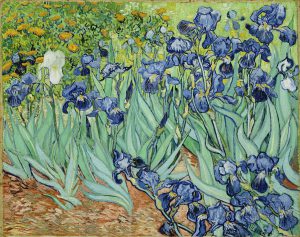
Irises by Vincent Van Gogh, 1889.
Have you noticed all of the blooming irises? Their striking shapes and colors grab my attention each time. Irises are named for the Greek word for rainbow and are often called flags. Irises, both true Iris and those with iris in the common name, are not only easy on the eyes, but also easy to grow in the Florida garden. North Florida gardeners have many varieties of iris to choose from, including those that prefer wet sites, drought-tolerant species, intricate hybrids, and native species.
All irises are in the plant family Iridaceae and have six flower petals; a lower set, called the sepals, or falls, and an upper set, known as standards, that are often upright. The base of the sepals, known as the signal, can have a variety of colors and patterns. Irises are clump forming plants with long, strap-shaped leaves. They need occasional dividing and propagate easy by rhizomes. Few pests bother them.
Here are a few common iris plants that grow well in our area.
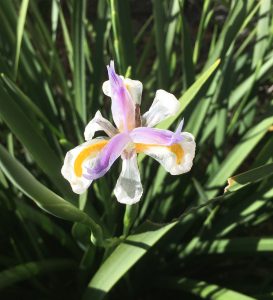
African Iris blooming on January 2nd, 2018 in the Leon County Extension Office Demonstration Garden. Credit: Mark Tancig, UF/IFAS Extension Leon County.
African Iris (Dietes vegeta)
This non-native plant is not actually a true Iris but is a tough and versatile plant. Its sepals are bright white with a yellow signal. The standards are purple. This plant can be grown in full sun or part shade, from standing water to droughty conditions. It works nicely as a border or foundation planting. Flowers only last a few days but are produced throughout the year. We had one blooming in our Demonstration Garden through a cold snap this past January. Cold weather can cause leaves to turn brown or gray, requiring some maintenance to improve appearance.
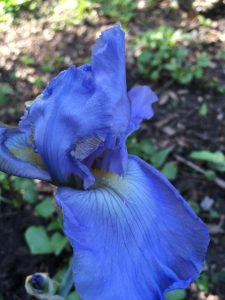
Bearded Iris. Credit: Mark Tancig, UF/IFAS Extension Leon County.
Bearded Iris (Iris x germanica)
A non-native, true Iris, bearded irises are the fancy hybrids that can come in many different colors. The “bearded” refers to the many hairs along the signal. Bearded irises prefer sunny locations and bloom in spring.
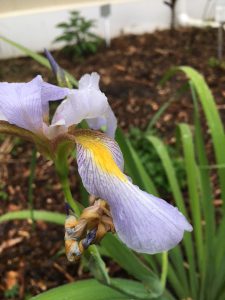
Iris versicolor. Credit: Mark Tancig, UF/IFAS Extension Leon County.
Blue Flag Iris (Iris versicolor and Iris virginica)
Two species of Iris go by the same common name, blue flag iris. These two are often misidentified in the nursery trade as well. Both have purple flowers that bloom in the spring, are native, and occur naturally in wetland areas. Gardener can have easy success with these in irrigated and/or rain gardens with some light shade. To tell the two apart requires a careful look at the lower sepals, or falls. Iris versicolor’s sepal has a greenish-yellow signal (base), surrounded by a white background with dark purple veins. The sepal of I. virginica has a bright yellow signal with little prominent veining. They also both have a 3-angled fruit.
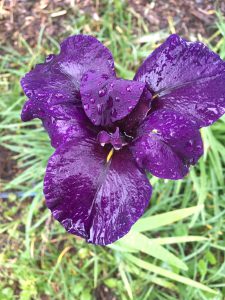
A Louisiana iris hybrid. Credit: Mark Tancig, UF/IFAS Extension Leon County.
Louisiana Iris (Iris spp.)
The name Louisiana iris refers to five true Iris species – I. brevicaulis, I. fulva, I. giganticaerulea, I. hexagona, and I. nelsonii – that are native in and around Louisiana. They easily hybridize with each other and these hybrids have become popular garden cultivars. Louisiana iris prefer moist soils and full sun.
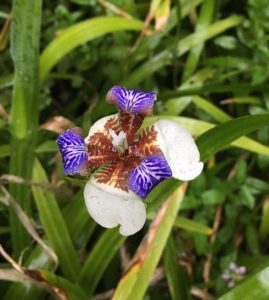
Walking Iris (Neomarica gracilis). Credit: Mark Tancig, UF/IFAS Extension Leon County.
Walking Iris (Neomarica spp.)
Another unofficial iris, most plants in the Neomarica genus share the same “walking” attribute. Small plantlets can develop at the top of the flower stalk and then fall over to start a new clump of plants. These do best in part shade to shade and have a long flowering period. They are somewhat cold tender so may die back but will return in the spring.
Yellow Flag Iris (Iris pseudoacorus)
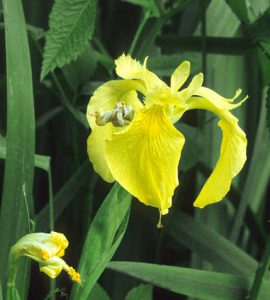
The invasive, exotic yellow iris. Credit: Ann Murray, UF/IFAS.
This non-native Iris is one that you want to keep out of the garden. Yellow flag iris is known to invade natural wetlands and has been designated invasive by the UF/IFAS Assessment of Non-Native Plants. It’s easily distinguished from the other irises listed above by its bright yellow flowers. If you have this iris, remove fruit and carefully dig out the rhizomes, place in a trash bag, and dispose of it in your solid waste bin.
For questions regarding iris identification or care, contact your local UF/IFAS Extension Office.
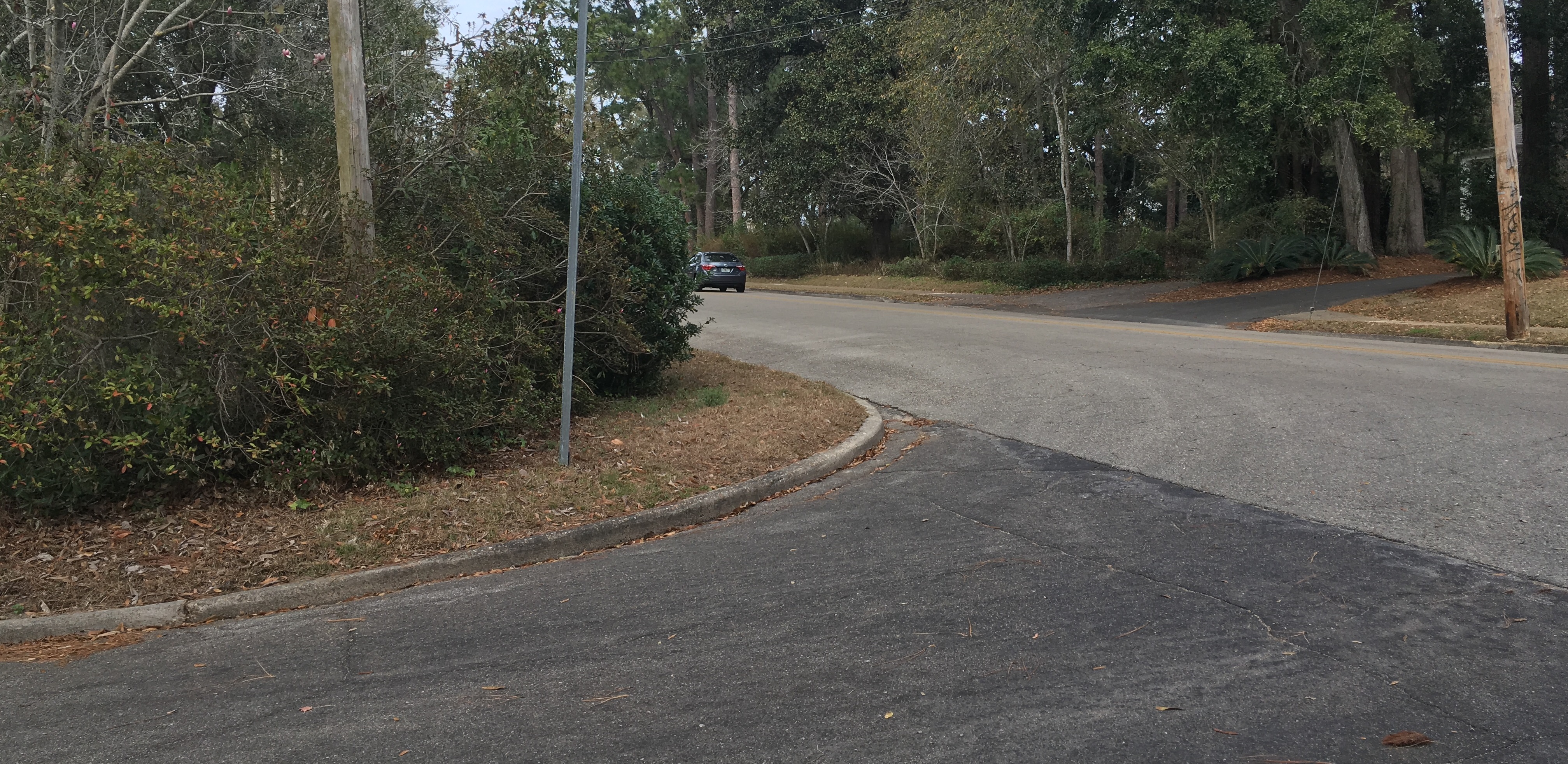
by Mark Tancig | Mar 26, 2018
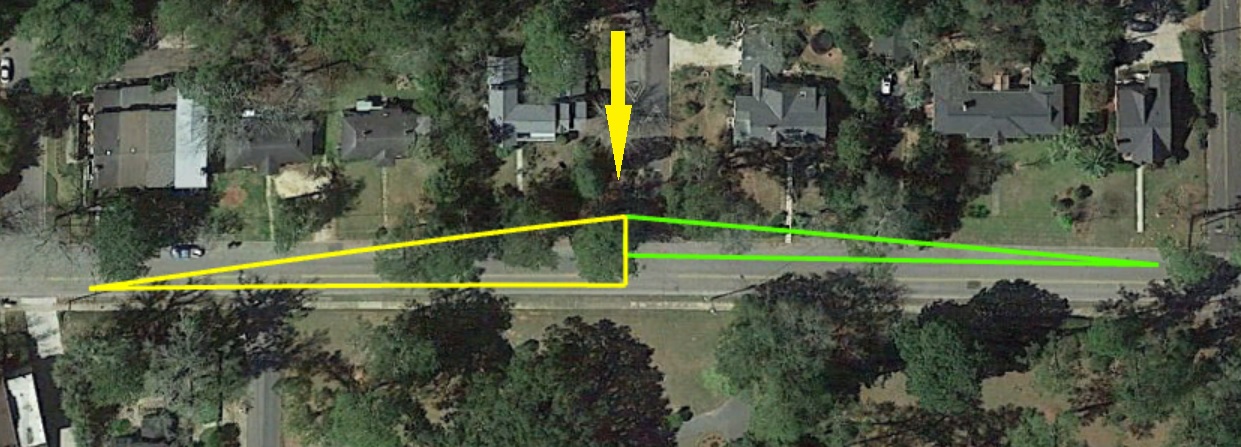
How many times have you pulled up to an intersection and couldn’t see oncoming traffic because a shrub was in the way? It’s frustrating, and unsafe. To help each other out, we should all pay attention to landscape plants that may be blocking the view of oncoming traffic and/or pedestrians, including your own driveway. Keeping a clear sight distance doesn’t mean you need a moonscape, but proper planning and maintenance of the landscape can look good and keep a clear sight distance.
“Site distance” is what traffic engineers call being able to see driving lanes and sidewalks, in both directions. I knew engineers had such a term and assumed they would have a precise way to measure it. Of course, since they’re engineers, they did. A local traffic engineer with the Leon County Public Works Department sent me the sketch. The figure should help, but, basically, you need to think of it as a sight triangles. The three points in each triangle are 1) the driver’s location at an intersection stop (where triangles meet), 2) the centerline of each lane, and 3) a point 300 – 500 down each lane. To determine if the view is clear, stand where a driver would stop, and approximate the height of the driver’s eye.
Please be safe as you rush to measure!
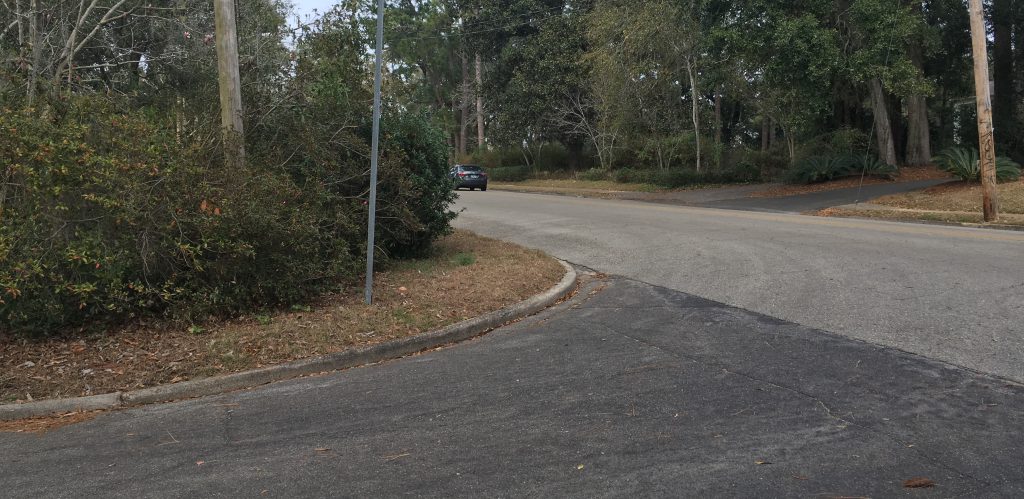
I can’t see if anyone’s coming! Credit: Mark Tancig/UF IFAS.
If you have vegetation in the way, assess the situation. First thing to determine is what plant(s) you have. If you don’t know, send a photo to your local Extension Office. Next, determine if the identified plant(s) can be pruned to get out of view and/or below the height of the driver’s eye. Transplanting to another location is a possibility, if it’s a plant that transplants well and isn’t too large. Otherwise, removing and replacing is the best option for the safety of the community.
When needing a low-growing replacement, consider the following Florida-Friendly plants:
African Iris (Dietes vegata) – Part Sun/Shade
Black-eyed Susan (Rudbeckia spp.) – Sun
Blue-eyed grass (Sisyrinchium angustifolium) – Part Sun/Shade
Butterweed (Packera glabella) – Shade
Coontie (Zamia florida) – Sun – Shade
Lily of the Nile (Agapanthus orientalis) – Part Sun/Shade
There are many, many more plants to choose from, including dwarf varieties of common ornamental plants. Your local Extension Office can help provide resources to help you make a good choice. Online resources, such as the Florida-Friendly Landscaping Pattern Books and the Guide to Plant Selection and Landscape Design, are also available.
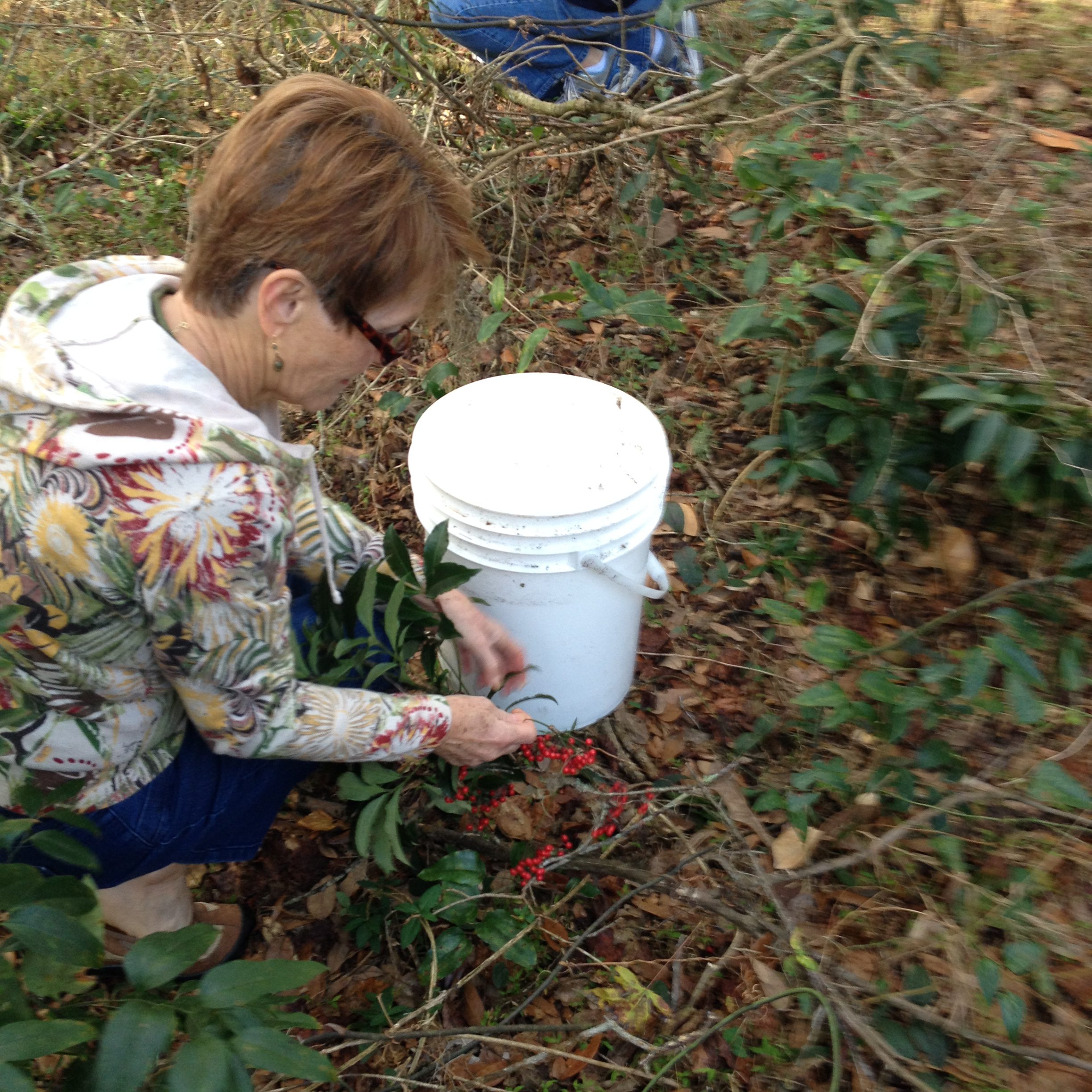
by Mark Tancig | Feb 5, 2018
An important skill for the Florida gardener is to be able to identify and control invasive, exotic plant species. These plants invade and disrupt Florida’s unique natural ecosystems, often spreading from surrounding urban and suburban landscapes. Being proactive in reducing their spread helps protect the integrity of Florida’s natural areas. Cooler days, fewer bugs, dormant vegetation (including poison ivy!), and striking plant characteristics make this time of year perfect for identifying and controlling invasive, exotic plants in urban/suburban woodlands. For additional motivation, February 26 through March 2 has been proclaimed National Invasive Species Awareness Week.
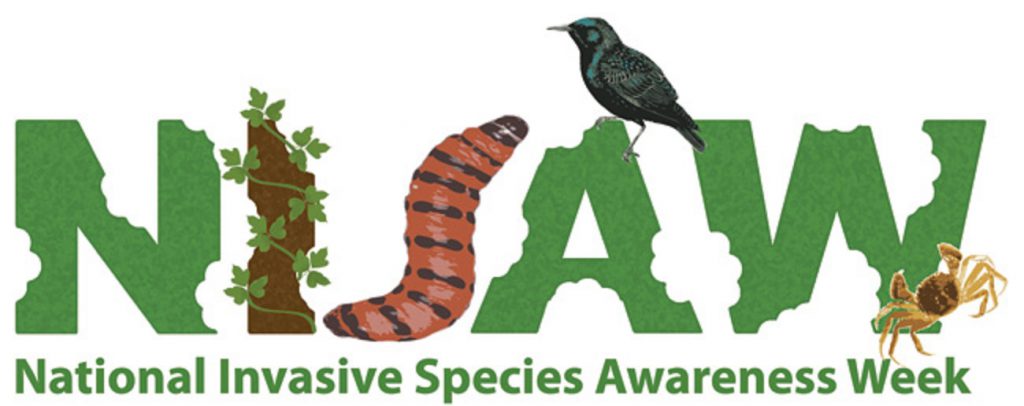
National Invasive Species Awareness Week is February 26 to March 2 this year.
In north Florida, two easily recognizable invasive, exotic plants are coral Ardisia (Ardisia crenata) and heavenly bamboo (Nandina domestica). Both of these plants were introduced decades ago as ornamental plants due to their showy foliage and fruit and ease of cultivation. I picture an adventuring botanist or gardener returning from some exotic locale and sharing what a beautiful and easy growing plant they had found. These characteristics make them easy to notice.
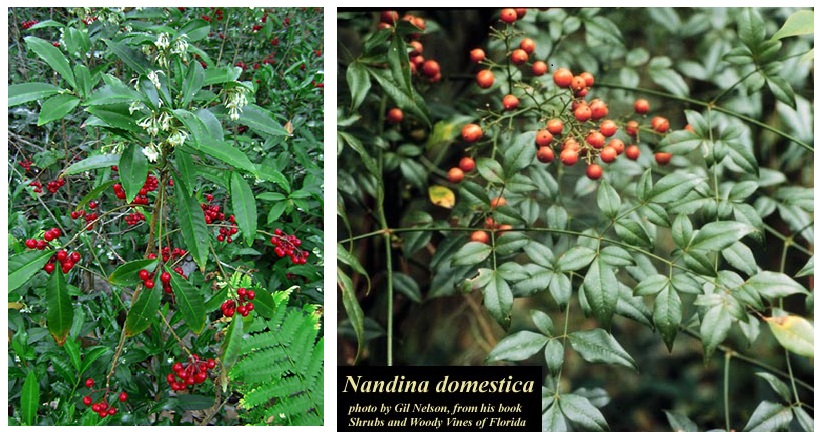
Coral Ardisia (left) and heavenly bamboo (right) are easy to recognize this time of year. Credit: UF/IFAS; Gil Nelson.
In small areas, manual control methods can be used to successfully rid an area of these common pest plants. Simply pick off the berries and place them in a small container – a 5-gallon bucket works great. Pull up the mature plant being sure to remove the roots. The seeds should be double-bagged and placed in the garbage for disposal in a landfill. The plants can be tossed to the side and allowed to dry out and breakdown. For larger plants, a shovel or root jack can be used to help ensure that the roots are removed from the soil. Follow up is often necessary for total control.
Chemical control methods are more efficient and practical for large areas. County Extension offices can help you select the right herbicide control program for your individual site and particular invasive, exotic species present.
During February and leading up to National Invasive Species Awareness Week, look for opportunities in your community to help rid natural areas of these pesky plants. For more information on invasive, exotic species, including photos, videos, and control recommendations, visit the UF/IFAS Center for Aquatic and Invasive Plants website – plants.ifas.ufl.edu.

You can help rid local natural areas of invasive, exotic plants. Credit: Mark Tancig
by Mark Tancig | Jan 18, 2018


Come on by and smell the flowers! Credit: Mark Tancig/UF IFAS Extension.
At this time of year, UF IFAS Extension agents across the state are compiling all of their phone calls, emails, field visits, number of programs held and participants attended to complete their annual report of accomplishment. As an extension agent, I can vouch that our annual reports are a bit of a record keeping challenge and a little stressful since it is the sole document that determines our career. However, after completing the records review and tying it all together, seeing all we do locally and statewide is pretty amazing. If you’ve been to an extension office for a class, called for a recommendation, and/or asked a question at a community event, then you know how handy it is to get some good, trusted advice. Looking over the numbers and reviewing responses from the participants highlights the reach and impact of extension in the community.
The goal of the Extension Service, going back to the early 1900’s, is to provide scientific knowledge and expertise to the public through educational programs. Our educational programs are designed to be interesting to attend, but also to pass along information to help meet challenges and issues faced by our state and/or region. You may come to a class on growing roses and leave with new information about proper pest control. You may attend a food canning class and leave with new food safety knowledge. You found a camp for your child during the summer and they came back knowing how to compost and build robots. Our priorities, set by Dean Nick Place, address economic, environmental, health, and social concerns of Floridians. Your kid had fun and learned about the need to recycle and turn food waste into plant food, helping to meet waste reduction goals and giving them the knowledge and skills to grow their own food.
Extension agents need to show in their reports that, not only are people coming, but they’re learning and doing. That’s why attendees are often asked to fill out surveys after workshops and sometimes answer follow up emails. We also get a lot of feedback from folks that were happy with our services. So, please let us know if you gained knowledge that changed something in your life for the better. It’s also not a bad idea to call or write your elected officials and tell them thanks for supporting extension, a cooperative effort between the federal, state, and county governments.

Worm composting attendees. Credit: Mark Tancig/UF IFAS Extension.
The numbers speak for themselves:
- In 2016, nearly 60 million connections were made statewide. Local extension offices connect with hundreds of thousands of citizens a year!
- Based on statewide survey data, 77% of those that called for advice said it solved their problem.
- Of those surveyed, 71% said they either saved money, developed their skills, conserved water or energy, or improved their health or well-being.
- Over 90% consider the information, up-to-date, accurate, and easy to understand.
Now that reports are done for this year, it’s time to start planning for 2018’s impacts. Agents are planning activities that will be of interest to and meet the needs of their communities. Keep a lookout for upcoming events by visiting your local county extension office’s webpage and/or Facebook page. You can also give them a call or, even better, go by and meet your local agents and staff.




















